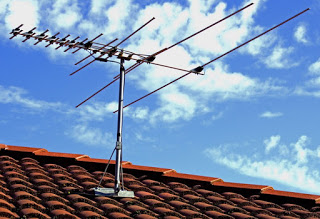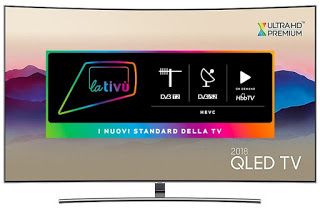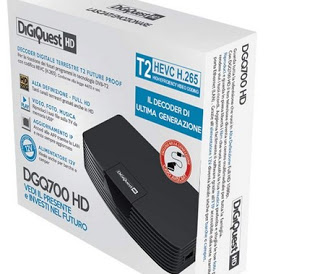 We hear more and more often about a new terrestrial digital video that will force us, in most cases, to equip our LCD TVs with an additional decoder in order to continue watching the classic TV channels. Unfortunately, the information provided is not always very clear and leaves doubt about the compatibility of our TV.
We hear more and more often about a new terrestrial digital video that will force us, in most cases, to equip our LCD TVs with an additional decoder in order to continue watching the classic TV channels. Unfortunately, the information provided is not always very clear and leaves doubt about the compatibility of our TV.In this guide we will show you how understand if the TV is DVB-T2, also showing you all the useful information on this technology, so you can be ready when the transition takes place and understand if our TV in the living room or in the kitchen is already ready to receive the new signal or we will have to equip ourselves with a decoder shortly. In the event that our TV is incompatible, just visit the chapter dedicated to decoders to remedy immediately.
READ ALSO: Best Smart TV for app system from Samsung, Sony and LG
What is DVB-T2
DVB-T2 is the new standard of digital terrestrial transmission born as an evolution of the previous DVB-T protocol (introduced in 2010), able to bring (on paper) higher quality and a growing number of television channels.
With it we should see the widespread diffusion of high definition (the most famous channels at 1080i, while the smaller ones at 720i) and the growth of 4K UHD broadcasts, which can only be reached via satellite (Sky or tivùsat). Together with the new protocol a new codec will be used to compress the audio / video signal, ie HEVC (also known on PC as H.265). The combination of the two elements will bring the television over the air into the new millennium, with quality content, an increasingly frequent interaction with Internet content (thanks to HbbTV, that is the new generation interactive TV) and an ever-increasing supply of channels, in order to compete with online streaming sites (which in recent years have become the easiest and fastest way to watch movies and TV series).
Although there is still plenty of time to adapt, we need to consider that since July of 2022 TV channels will only support the new DVB-T2 standard.
How to recognize if a TV is DVB-T2
If we have purchased a TV after January 1, 2017, we must not even ask ourselves the doubt: the sale of DVB-T2 TV is mandatory from that date, so the newer TVs are already ready for the transmission change (we will have to do practically nothing but a tuning the day of the signal switch ). To facilitate the choice it is also possible to find a logo on the new TVs for sale, able to clearly show the features required for DVB-T2.
If instead the TV is older or we are afraid we have purchased some “warehouse waste” in 2017, we must retrieve the information sheet or the TV manual and check if, in the technical information, the following elements are present:
- DVB-T2 digital terrestrial tuner
- Codec HEVC (H.265)
Only these two elements will guarantee the perfect display of the new channels at the time of transmission change: the other elements (such as the presence or absence of the Smart TV features or the presence of HbbTV) are superfluous and alone do not guarantee the vision of the channels in DVB-T2.
Without the compatibility with the two elements listed above we risk finding ourselves in one of the two scenarios described below:
- I hear the audio but I don’t see the video: our TV is compatible with DVB-T2, but does not have support for the HEVC codece, resulting in fact incompatible with the images transmitted.
- I hear neither audio nor video, I don’t see any channel: the worst case scenario, where our TV is completely incompatible with DVB-T2 and HEVC.
In both cases we will have to change the TV set (more expensive choice) or equip ourselves with a compatible decoder (much cheaper and more practical, as we will see in the next chapter).
How to integrate DVB-T2 on all TVs
In the event of total or partial incompatibility, we must therefore equip ourselves with a decoder; this scenario immediately brings to mind the great nightmare passed by many Italians in 2010, with two separate remote controls to manage the TV and the decoder (with great confusion and frustration). Fortunately, the technology has continued and now, thanks to HDMI-CEC (an integrated feature on devices with HDMI port), we can only use the remote control of the decoder to do everything: raise / lower the volume, change channels and switch on / off decoder and TV together.
All we have to do is connect the new decoder via HDMI to our TV and try to use only the remote control of the new device: we should be able to manage our TV without having to use two remote controls.
The best digital terrestrial decoders we can buy are listed below:
- Digital Terrestrial Decoder, DVB-T2 Leelbox K2 (€ 25)
- Digiquest DGQ700 HD T2 HEVC – Digital Terrestrial Decoder (€ 27)
- Tempo 4000 DVB T2 Digital Terrestrial Decoder (€ 29)
- Echosat 2910 S DVB-T / T2 Digital Receiver (30 €)
- STRONG SRT 8211 digital terrestrial HD Decoder DVBT2 (€ 33)
Spending less than € 40 we will be able to update any TV in our possession, without having to pay for a new TV.
If instead we wanted to immediately bypass the problem, we remind you that the tivùsat satellite platform is free and already has support for all modern standards, we will only need to equip ourselves with a satellite dish and a specific decoder for the satellite signal, as seen in our guide on How to use 4K on Smart TV.
READ ALSO: TV card to watch digital terrestrial on your computer
Conclusions
Compared to the previous switch that occurred in 2010 (with numerous CRT televisions to be updated), this time the transition will be less painful, particularly if we have focused on a high-end TV in this decade or if we have decided to buy a new TV since 2017 onwards. In all other cases we can postpone the great expense for the new TV by purchasing a small low cost decoder (25 € is enough), so that we can continue to use our old LCD or plasma TV without any problem.
If we need to buy a new TV, we recommend that you read our guide on How to choose and buy the best Smart TV.
If instead we wanted an alternative to the decoder, we can try to visualize the digital terrestrial channels directly from the Internet, taking advantage of the streaming flows as described in our guide How to view TV channels on Chromecast (without antenna).




Is it possible to have a DVB-T2 to DVB-T decoder, which would just have a DVB-T2 antenna input (coaxial), and a DVB-T antenna output (coaxial), so you could use the remote of your existing TV as you would be receiving compatible signal.